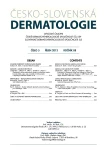-
Medical journals
- Career
Evaluation of Frequency of the Food Allergy to wheat Flour, Cow’s Milk, Eggs, Soya and Peanuts in 240 Patients with Atopic Eczema Older than 14 Years
Authors: J. Čelakovská 1; K. Ettlerová 2; K. Ettler 1; J. Vaněčková 1; J. Bukač 3
Authors‘ workplace: Klinika nemocí kožních a pohlavních FN a LF UK Hradec Králové přednosta doc. MUDr. Karel Ettler, CSc. 1; Ambulance klinické imunologie a alergologie, Hradec Králové vedoucí MUDr. Květuše Ettlerová 2; Ústav lékařské biofyziky LF UK Hradec Králové, přednosta doc. Ing. Josef Hanuš, CSc. 3
Published in: Čes-slov Derm, 88, 2013, No. 5, p. 214-222
Category: Clinical and laboratory Research
Overview
Our aim was the evaluation of food allergy to egg’s white and yolk, peanuts, soya, cow’s milk and wheat and follow up of patients with confirmed food allergy. The study included 240 patients with atopic dermatitis (70 men, 170 women, average age was 26.4 from the age of 14 to 63 years, with the median SCORAD 31 points at the beginning of the study). Complete dermatological and allergological examination was performed, including specific IgE, atopy patch tests and skin prick tests. In patients with positive results the diagnostic hypoallergenic diet was introduced and challenge test was performed with suspected food. In patients suffering from moderate or severe form of atopic dermatitis the exposure test with cow milk and wheat flour was performed even if laboratory tests were negative. The positivite tests (including challenge tests) were recorded altogether in 143 patients (60%). From them the food allergy was confirmed in 65 patients (27.5%) and the sensitisation was recorded in 78 patients (32.5%). Allergy to peanuts was confirmed in 20%, to egg in 6%, to soya in 3%, to wheat in 2.5% and to milk in 0.8% of patients. The most common symptom was oral allergy syndrome in 17% of patients after ingestion of peanuts. The worsening of atopic dermatitis was recorded in 7% of patients after ingestion of egg, wheat and soya. The course of atopic dermatitis showed a positive trend at 3, 6 and 12 months of follow-up after avoiding the offending allergen. We conclude that the diagnostic work-up of food allergy in patients suffering from atopic dermatitis should comprise not only the laboratory methods, but as well the diagnostic hypoallergenic diet and the challenge test.
Key words:
atopic dermatitis – food allergy – specific IgE – atopy patch tests – skin prick tests – challenge tests
Sources
1. BREUER, K., HERATIZADEH, A., WULF, A. et al. Late eczematous reactions to food in children with atopic dermatitis. Clin. Exp. Allergy, 2004, 34, p. 817–24.
2. ČELAKOVSKÁ, J., ETTLEROVÁ, K., VANĚČKOVÁ, J., ETTLER, K. Význam diagnostické hypoalergenní diety u pacientů s atopickým ekzémem. Čes-slov Derm, 2011, roč. 86, č. 3, s. 138–143.
3. ČELAKOVSKÁ, J., ETTLEROVÁ, K., ETTLER, K., VANĚČKOVÁ, J., BUKAČ, J. Význam potravinové alergie na sóju u pacientů s atopickým ekzémem starších 14 let. Čes-slov Derm, 2010, roč. 85, č. 1, s. 14–20.
4. ČELAKOVSKÁ, J., ETTLEROVÁ, K., VANĚČKOVÁ, J., ETTLER, K. Výskyt potravinové alergie na vaječné bílkoviny u pacientů s atopickým ekzémem starších 14 let. Čes-slov Derm., 2010, roč. 85, č. 5, s. 264–273.
5. DARSOW, U., LAIFAOUI, J., KERSCHENLOHR, K., WOLLENBERG, A., PRZYBILLA, B., WÜTHRICH, B., BORELLI, S., GIUSTI, F., SEIDENARI, S., DRZIMALLA, K., SIMON, D., DISCH, R. The prevalence of positive reactions in the atopy patch test with aeroallergens and food allergens in subjects with atopic eczema: a European multicenter study. Allergy, 2004, 59, 12, p. 1318–1325.
6. HANIFIN, J., RAJKA, G. Diagnostic features of atopic dermatitis. Acta Derm. Venereol., 1980, 92, p. 44–47.
7. HERATIZADEH, A., WICHMANN, K., WERFEL, T. Food allergy and atopic dermatitis: how are they connected? Current. Allergy Asthma Reports, 2011, 11, p. 284–291.
8. KJAER, H., ELLER, E., ANDERSEN, K. et al. The association between early sensitization patterns and subsequent allergic disease. The DARC birth cohort study. Pediatr. Allergy Immunol., 2009, 20, p. 726–734.
9. KUNZ, B., ORANJE, A., LABRÉZE, L., STALDER, J., RING, J., TAIEB, A. Clinical validation and guidelines for the SCORAD index: consensus report of the European task Force on Atopic Dermatitis. Dermatology, 1997, 195, 1, p. 10–19.
10. LACK, G. Clinical practice. Food allergy. N. Engl. J. Med., 2008, 359, p. 1252–1260.
11. NIGGEMANN, B., REIBEL, S., ROEHR, C.,WAHN, U. Predictors of positive food challenge outcome in non - -IgE-mediated reactions to food in children with atopic dermatitis. J. Allergy Clin. Immunol., 2001, 108, p. 1053–1058.
12. SUH, K. Food allergy and atopic dermatitis: separating fact from fiction. Semin. Cutan. Med. Surg., 2010, 29, p. 72–78.
13. ŠPIČÁK, V., PANZNER, P. Alergologie. Galén: Praha 2004, 1. vydání, ISBN 80-7262-265.
14. WORM, M., FORSCHNER, K., LEE, H. et al. Frequency of atopic dermatitis and relevance of food allergy in adults in Germany. Acta Derm. Venereol., 2006, 86, p. 119–122.
Labels
Dermatology & STDs Paediatric dermatology & STDs
Article was published inCzech-Slovak Dermatology

2013 Issue 5
Most read in this issue- Severe Drug Eruptions
- Evaluation of Frequency of the Food Allergy to wheat Flour, Cow’s Milk, Eggs, Soya and Peanuts in 240 Patients with Atopic Eczema Older than 14 Years
Login#ADS_BOTTOM_SCRIPTS#Forgotten passwordEnter the email address that you registered with. We will send you instructions on how to set a new password.
- Career

